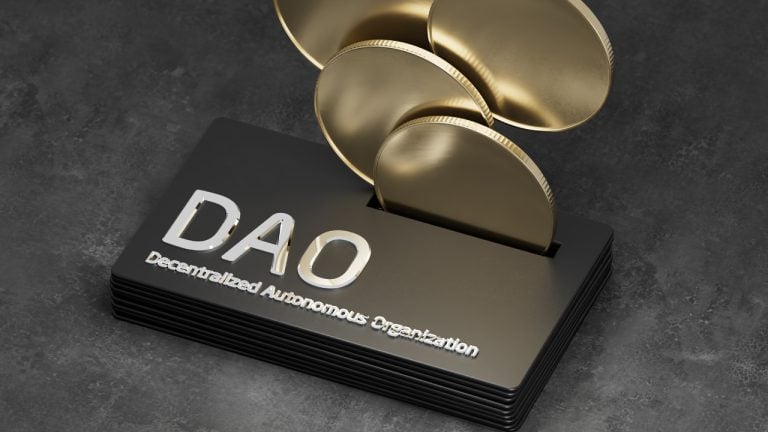 The cryptocurrency economy is doing well during the third week of the new year, compared to the end of 2022. It is currently valued at $993.17 billion, as many digital assets have seen double-digit gains during the last two weeks. While some of the top ten cryptocurrencies, like bitcoin and ethereum, are performing well, a […]
The cryptocurrency economy is doing well during the third week of the new year, compared to the end of 2022. It is currently valued at $993.17 billion, as many digital assets have seen double-digit gains during the last two weeks. While some of the top ten cryptocurrencies, like bitcoin and ethereum, are performing well, a […]
Amid the ongoing crypto winter, digital asset management giant Grayscale’s decentralized finance (DeFi) investment product has started trading on the financial market OTC Markets. The Grayscale DeFi Fund currently gives customers exposure to the decentralized exchanges Uniswap (UNI) and Curve (CRV), the decentralized lending platforms Aave (AAVE) and Compound (COMP), and Maker (MKR), a governance […]
The post Digital Asset Giant Grayscale’s DeFi Investment Product Starts Trading on OTC Markets Amid Crypto Bear Market appeared first on The Daily Hodl.

The last week of October turned bearish for the DeFi market despite the string of hacks, as the majority of the DeFi protocols registered bullish weekly gains.
Welcome to Finance Redefined, your weekly dose of essential decentralized finance (DeFi) insights — a newsletter crafted to bring you significant developments over the last week.
After the Mango Markets exploit last week, Compound protocol paused the supply of four tokens as lending collateral to protect it against any price manipulation.
Crypto staking protocol Freeway said one of its trading strategies “appears to have failed,” forcing the firm to halt services earlier this week. October continues to be dominated by DeFi hacks as another DeFi lockup protocol, Team Finance, lost $14.5 million during contract migration, despite an audit clearance.
MakerDAO community voted to approve the custody of $1.6 billion USD Coin (USDC) with the institutional brokerage platform Coinbase Prime.
The top 100 DeFi tokens showed bullish momentum after nearly three weeks of price performance dominated by the bears. Majority of the tokens traded in the green on the weekly charts, with several of them seeing double-digit gains.
Decentralized lending protocol Compound has paused the supply of four tokens as lending collateral on its platform, aiming to protect users against potential attacks involving price manipulation, similar to the recent $117 million exploit of Mango Markets, according to a proposal on Compound’s governance forum that was recently passed.
With the pause, users will not be able to deposit Yearn.finance’s YFI (YFI), 0x’s ZRX, Basic Attention Token (BAT) and Maker’s MKR (MKR) as collateral to take loans.
Crypto staking platform Freeway pointed at the failure of one of its cryptocurrency trading strategies, along with market conditions, as the leading reason for halting user withdrawals earlier this week.
The crypto yield platform on Oct. 23 announced it was halting various transactions relating to its high-yield Supercharger product, citing “unprecedented volatility” at the time, without giving any more details at the time, which saw its token price plummet.
DeFi lockup protocol Team Finance said that over $14.5 million worth of tokens were exploited through the Uniswap v2 to v3 migration function on its platform. As told by blockchain security firm PeckShield, the hacker transferred liquidity from Uniswap v2 assets on Team Finance to an attacker-controlled v3 pair with skewed pricing. By locking tokens to the contract, the attacker bypassed existing validation mechanisms and pocketed the huge leftovers as a refund for profit.
Uniswap v3 was designed with better efficiency for liquidity providers (LP) than v2 on its decentralized exchange. However, v2 smart contracts are still operational, and users must interact with a migration smart contract to migrate their LP assets from v2 to v3. PeckShield estimated that the initial attack vector required for this interaction costs just 1.76 Ether (ETH).
Coinbase Prime, an institutional prime brokerage platform for crypto assets, announced on Oct. 24 that it has entered into a partnership with MakerDAO to become a custodian of $1.6 billion worth of the stablecoin USDC, of which MakerDAO is the largest single holder.
The MakerDAO community voted to approve the custodianship, which will allow its community to earn a 1.5% reward on its USDC while holding funds with a leading institutional custodian.
Analytical data reveals that DeFi’s total value registered a surge toward the end of October, with the total value locked (TVL) rising above $50 billion at the time of writing. Data from Cointelegraph Markets Pro and TradingView show that DeFi’s top 100 tokens by market capitalization had a bullish week, with the majority of the tokens trading in the green on the 7-day chart, barring a few.

Theta Network (THETA) was the biggest gainer over the past week, registering a weekly surge of 14.68%, followed by Avalance (AVAX) with a 12.85% surge on the 7-day chart. Many other DeFi tokens registered single-digit weekly gains, barring a few that traded in the red.
Thanks for reading our summary of this week’s most impactful DeFi developments. Join us next Friday for more stories, insights and education in this dynamically advancing space.
 Since January 2022, the entire crypto economy has shed $1.36 trillion in value, as the market capitalization dropped from $2.34 trillion to today’s $979 billion. While the crypto economy is down in value, trade volumes are lower, and the value locked in decentralized finance (defi) has shed billions, treasuries held by decentralized autonomous organizations (DAOs) […]
Since January 2022, the entire crypto economy has shed $1.36 trillion in value, as the market capitalization dropped from $2.34 trillion to today’s $979 billion. While the crypto economy is down in value, trade volumes are lower, and the value locked in decentralized finance (defi) has shed billions, treasuries held by decentralized autonomous organizations (DAOs) […]
Accredited institutions can borrow USD OR USDC starting at 6% APR, according to the company.
Compound Treasury, a cash management solution for institutions powered by the Compound Protocol, announced on Sept.14 that accredited institutions can now borrow USD or USDC with fixed rates starting from 6% APR, using Bitcoin, Ethereum, and supported ERC-20 assets as collateral.
Starting today, to meet the growing demand for liquidity, institutions can now borrow from Compound Treasury, using digital assets as collateral.https://t.co/xgDIep18Qa
— Compound Labs (@compoundfinance) September 14, 2022
The Defi-backed company whose notable clients include crypto companies, fintech institutions, and banks, shared that the decision was made in response to recent market volatility, which has created a more robust demand for liquidity.
Reid Cuming, VP of Compound Treasury said, “Compound Treasury can now address demand for liquidity with simple, reliable borrowing solution, while continuing to provide the same trusted service we’ve delivered to clients earning interest over the past year.” He added:
“Introducing borrowing expands our cash management product to meet more needs of our clients.”
In an official statement, the company announced that borrowing for clients will remain flexible, with “an open-ended term” and “no repayment schedule”, so long as participating clients remain overcollateralized. Collateral provided by borrowing institutions is not expected to leave Compound Treasury’s control, thereby increasing transparency and safety of funds.
Liquidity for the program will be provided by Compound Treasury’s clients and the Compound Protocol, which currently has over $3 billion in assets and more than $285 billion in total transaction volume since the company began operating.
This announcement by Compound Treasury comes after the Defi-backed company received a B- credit rating from S&P Global in May 2022, making the company the first of its kind to receive a credit rating from a major agency.

Decentralized lending platform Compound has launched a new “streamlined” version of its protocol called “Compound III.” With the update, Compound (COMP), an algorithmic, autonomous interest rate protocol, is moving away from a pooled-risk model where users can borrow any asset, according to a new blog post from Robert Leshner, the founder of Compound Finance. Explains […]
The post DeFi Lending Platform Compound (COMP) Launches New ‘Streamlined’ Protocol Upgrade appeared first on The Daily Hodl.

CeDeFi is a new financial system that combines centralized and decentralized systems. It provides privacy, reduced fees and ease of use.
Currently, CeDeFi’s main downside is the high learning curve associated with its protocols because of their complexity. The concept is still young, and more intuitive and user-friendly interfaces are bound to emerge over time.
CeDeFi also relies heavily on Ethereum, given that most CeDeFi protocols are still built on the Ethereum blockchain. If Ethereum fails, CeDeFi will likely fail as well. However, this risk is mitigated by the fact that other blockchains are beginning to adopt CeDeFi protocols.
Another disadvantage of CeDeFi is that it’s still relatively new and unproven. While the sector has seen tremendous growth in the past year, it’s still in its early stages. As such, CeDeFi protocols are subject to high volatility and therefore may not yet be ready for mass adoption.
Finally, CeDeFi is not without its fair share of scams. Due to the lack of regulation, there have been several scams in the CeDeFi space. Therefore, it is essential to be vigilant, use only reputable CeDeFi protocols and view CeDeFi as a possible solution for integrating DeFi products and applications into mainstream financial systems.
Purchase a licence for this article. Powered by SharpShark.
Among the advantages of CeDeFi are lower fees, better security, accessibility, speed and lower cost.
CeDeFi's innovative approach to decentralized banking enables users to trade CeDeFi crypto assets without requiring a centralized exchange. This implies that users may transact directly with one another, removing the need for an intermediary.
Among CeDeFi’s major advantages is lower fees. CeDeFi transactions cost lower than those on comparable platforms since there are fewer middlemen involved, especially on networks that are not Ethereum-based.
Ethereum has very high gas fees, for instance, with DEX transactions running into hundreds of dollars. It also often causes network congestion issues, leading to delays. Binance CeDeFi, on the other hand, has much lower fees and accelerates transactions by allowing users to accept fees in a few seconds.
Another notable advantage is improved security. Hackers will find it far harder to break into the CeDeFi network than they will with traditional banking systems because of the network's decentralized structure.
In addition, CeDeFi is incredibly accessible as anyone who has an Ethereum wallet can make use of the CeDeFi protocols. It lowers entry barriers for less experienced users and enables them to explore more about DeFi by presenting verified trade options vetted by multiple criteria, including KYC, fees and more.
Financial transactions conducted through CeDeFi can also be handled considerably faster than those performed through traditional financial systems. This is because CeDeFi doesn't need to wait for approval from a third party, which can often take several days to weeks.
CeDeFi technologies are also more flexible than conventional financial systems, allowing them to be altered to meet the needs of each user. For instance, the automated yield portfolio (YAP) strategy by Midas diversifies portfolio risk by exposing investors to a variety of assets without the burden of buying separate crypto assets. Most significantly, YAPs go through monthly rebalancing at no extra expense to investors to maximize profits.
By securing profits from better-performing assets while reinvesting in the underperforming assets, this rebalancing enables Midas to take advantage of market fluctuations in the hope of providing steady portfolio growth over the long term.
Furthermore, as projects and tokens are evaluated and audited thoroughly by CeDeFi exchanges, safer transactions are possible. CeDeFi provides more privacy than conventional payment systems because its decentralized network makes it harder for outside parties to track user transactions.
Binance plays a huge part in the rise of CeDeFi — it was Binance’s CEO, Changpeng Zhao, who coined the term “CeDeFi,” in September 2020, during the launch of Binance Smart Chain.
Considering that Ethereum's popularity is attributable to smart contracts functionality, Binance also realized it had to create another blockchain network to compete with Ethereum and its DeFi ecosystem. As a result, Binance rebranded its existing blockchain network to BNB Smart Chain, a fork of Ethereum with optimizations for low fees and high transaction throughput.
While it sacrifices decentralization and censorship resistance — it still seems to be paying off. Although it was criticized by decentralization advocates, BNB Chain grew exponentially from September 2020, thanks to its ability to fund projects quickly, leading to the rise of CeDeFi.
In addition to Binance, investors can establish hedged yield streams through existing digital tactics using Midas's hybrid CeDeFi investing platform for dependable passive income. Moreover, Midas claims to have a massive network of backend procedures in a volatile cryptocurrency market that seek to hedge and protect the front-end investment options offered to individuals.
Integration with a highly secure Fireblocks cryptocurrency custody and transfer technology has protected the Midas digital ecosystem. For stored custody assets, FireBlocks provides commercial-grade digital protection.
DeFi refers to a broad range of financial products and services built on blockchain technologies in the public blockchain space. It functions outside of traditional centralized systems like banks and credit cards.
These are accessible through decentralized applications (DApps), which operate on a peer-to-peer basis, removing the need for centralized authorities like banks, credit card companies or brokers. With DeFi, anyone can access alternative financial systems like lending and borrowing.
In CeFi, a centralized exchange handles all crypto trading, meaning users don’t have access to private keys or really own their crypto. They are also subject to the exchange's terms and conditions, prices and gas fees.
In contrast, DeFi users have complete control of their funds since no centralized authority handles transactions. Instead, a blockchain-based protocol allows users to buy, sell, store and trade their funds as they please. Both DeFi and CeFi have their pros and cons. CeFi makes it easier to convert fiat to crypto, unlike DeFi. But DeFi is permissionless and does not require a KYC process.
CeFi is a structured financial institution that lets consumers borrow or lend cryptocurrency through a controlled exchange.
It functions similarly to the conventional banking industry. Users use their cryptocurrency as collateral when borrowing money or earn interest on it when lending. The CeFi platform serves as the “custodian” of your digital assets. You relinquish control of your cryptocurrency when the CeFi platform “safeguards” it to make money. If the platform is hacked, your assets could be at risk.
CeFi has a larger market share than DeFi because CeFi platforms are more widely used. Binance, Coinbase and Diem are among the popular CeFi platforms. However, due to CeFi's expensive transaction fees brought on by third-party involvements, the lack of transparency and total ownership over your digital assets, DeFi became popular.
Some of the most popular examples of CeDeFi protocols include the MakerDAO, Synthetix and Compound, which offer DeFi-like capabilities while remaining centralized. A custodial crypto-investment platform like Midas.Investments is another example.
MakerDAO, Synthetix and Compound are all built on top of the Ethereum blockchain. Midas.Investments updated its platform in August 2022 to incorporate CeDeFi strategies. According to the Midas team, the new approach aims to mirror DeFi by creating smart contracts to handle asset management under various lending protocols. These include lending, borrowing and soft leverage, ideally allowing an influx of capital into the DeFi space.
As with many CeDeFi endeavors, Midas aims to provide its clients with DeFi options tailored to their risk profile while allowing access to hedged instruments from CeFi. To better understand CeDeFi, let’s first understand CeFi and DeFi.
CeDeFi is a union of CeFi and DeFi, combining the best features and attributes of the two financial systems.
For a while now, financial systems have been split into centralized finance (CeFi) and decentralized finance (DeFi). CeFi is a traditional, bank-enabled finance system, while DeFi is based on cryptocurrencies and smart contracts.
However, a new system, "CeDeFi," a combination of centralized and decentralized finance, has emerged and is gaining traction. So, what is CeDeFi, and how does it work?
CeDeFi offers the same features as DeFi protocols while being centralized, allowing people to access DeFi products like decentralized exchanges (DEXs), liquidity aggregators, yield farming tools and lending protocols — yet still leveraging the advantages of CeFi systems.
Unlike DeFi, which is permissionless and available for use by anyone, CeDeFi projects lean more toward centralization. They are often governed by a single or small group of entities, which allows them more control (similar to a CeFi).
Overall, the CeDeFi ecosystem, which is a hybrid of the centralized and decentralized models, aims to improve the traditional cryptocurrency model to allow for faster transactions, improved security, a larger transaction volume and comparatively lower fees than traditional systems.
 Ever since Celsius paused withdrawals on June 12, the company has been the focus of attention due to the lender’s financial hardships. A month later, Celsius filed for bankruptcy in the U.S. by leveraging the Chapter 11 process. Two days after the bankruptcy filing, a report disclosed that two people familiar with the matter allege […]
Ever since Celsius paused withdrawals on June 12, the company has been the focus of attention due to the lender’s financial hardships. A month later, Celsius filed for bankruptcy in the U.S. by leveraging the Chapter 11 process. Two days after the bankruptcy filing, a report disclosed that two people familiar with the matter allege […]
Releasing the results of its first credit score on the Aave Protocol, a decentralized credit scoring mechanism called Cred Protocol is set to expand to Compound and MakerDAO.
Cred Protocol, a decentralized credit scoring startup has unveiled the results of its first automated credit scoring system for users of decentralized finance (DeFi).
Cred Protocol CEO Julian Gay outlined the results in a Twitter thread, which showed how Cred successfully utilized past transaction behavior on the Aave protocol to assess the creditworthiness of future borrowers based on on-chain behavior in the DeFi space.
1/ Over the last few months, we've been working to build one of the first credit scores for DeFi.
— Julian Gay (@juliangay) July 14, 2022
Today, we're excited to share the results of our first credit score with the world!
Read more below
By using machine learning to assess time-based account attributes and analyze the user’s past transaction behavior, Cred Protocol generates a health factor score that predicts the likelihood of future liquidation for a single address, which, according to Gay, was one of the strongest baseline creditworthiness predictors.

Cred Protocol claims to make decentralized finance more accessible to the world by implementing trustworthy credit scores that would see “anyone with an internet connection” and “a good financial reputation” gain access to loans.
Where borrowers and lenders have their loan worthiness assessed by a central authority such as a credit bureau, DeFi makes it possible to run financial services with a peer-to-peer (P2P) system, eliminating the idea of an intermediary or central authority.
Prominent DeFi researcher Chris Blec raised concerns that a borrower could use multiple Ethereum addresses to skirt credit scoring — to which Gay responded that a potential solution was in Beta.
So it's just a credit score for that 1 Ethereum address? What if someone uses 10 different addresses?
— Chris Blec (@ChrisBlec) July 15, 2022
Cred Protocol is a small nine-person team based out of San Francisco with additional “hubs” in New York and London. However, Gay says that he aims to bring DeFi technology to more than one billion people.
In a Medium post, Cred outlined its plans to grow from the Aave protocol and expand its data analysis to other lending protocols like Compound and MakerDAO.
Two years ago, blockchain lending protocol Teller raised $1 million in a seed funding round to incorporate traditional credit scores into DeFi.
Related: Decentralized credit scores: How can blockchain tech change ratings
In November 2021, Credit DeFi Alliance (CreDA) officially launched a credit rating service that would ascertain a user’s creditworthiness with data from multiple blockchains. CreDA was developed to work using the CreDA Oracle by evaluating records of past transactions carried out by the user across several blockchains with the help of artificial intelligence (AI).
Recently, P2P lending protocol RociFi labs concluded a seed funding of $2.7 million in partnership with asset management firm GoldenTree, which is aimed toward expanding on-chain credit ratings for decentralized finance.

Fees spiked to a high of $8.36 million for Uniswap on June 15, beating out Ethereum on the same day at $7.99 million, and coincided with an 8.7% pump for UNI.
Decentralized exchange (DEX) Uniswap has overtaken its host blockchain Ethereum in terms of fees paid over a seven-day rolling average.
The surge appears part of a recent spate of high demand for DeFi amid the current bear market. Decentralized finance (DeFi) platforms such as AAVE and Synthetix have seen surges in fees paid over the past seven days, while their native tokens, and others such as Compound (COMP) have also boomed in price too.
According to data from Crypto Fees, traders on Uniswap accounted for an average daily total of $4.87 million worth of fees between June 15 and June 21, overtaking the average fees from Ethereum users which accounted for $4.58 million.
Uniswap’s most advanced V3 protocol (based on the Ethereum mainnet) accounted for the lion's share of the total fees with $4.4 million, while the V2 variant also contributed a notable $336,556.
During this period, Ethereum’s total fees only outpaced Uniswap’s on two days out of the seven. In terms of a peak day of fees generated, Uniswap topped out at $8.36 million on June 15, beating out Ethereum on the same day at $7.99 million.

Uniswap enables peer-to-peer (P2P) swaps of Ethereum-based tokens without having a central authority to facilitate trades. This is achieved by automated smart contracts. Under Uniswap’s fee structure, fees are paid by traders to liquidity providers who receive 100% of the fees on the DEX.
Related: Uniswap breaks $1T in volume — but has only been used by 3.9M addresses
Considering Ethereum is the blockchain home to the majority of DeFi, and is known for its expensive fee structure, a DEX such as Uniswap beating out the blockchain in fees over a week is notable.
According to data from CoinGecko, UNI has pumped 17.4% over the past seven days to sit at $5.18 at the time of writing. Recent acquisitions of the NFT marketplace aggregator Genie and the appointment of the former president of the New York Stock Exchange Stacey Cunningham as an advisor at Uniswap Labs may have contributed to this.
Uniswap is not the only platform to see a surge in its fees and token price of late, as data is also showing strong investor demand for several DeFi platforms despite the current bear market.
Lending protocol AAVE and synthetic derivatives trading platform Synthetix in particular are ranked third and fifth in terms of average fees paid over the past seven days with $981,883 and $600,214 apiece.
Much like Uniswap, AAVE saw a surge of fees on June 15, as its total increased by 69% to $1.44 million. Its native token AAVE has also pumped 22% since then.
Sythentix’s rise has been the most notable. The platform saw a whopping 928% increase in fees paid between June 11 and June 13 as the figure rose to $843,297. The total fees then dropped to roughly $400,000 by June 17, before surging another 150% to roughly $1 million on June 19.
The boom can also be seen by observing Synthetix’s native asset SNX, the price of which has gained 105% since June 19 to sit at $3.08 at the time of writing. A key reason behind this appears to be the Synthetix Improvement Proposal 120 that went live last week that enables users to “atomically exchange assets without fee reclamation” therefore increasing the speed of trading.
Bucking this trend however, fees on lending platform Compound have been declining since April, and generated a mere seven day rolling average of $11,753 over the past week, though its native token COMP has increased 16.7% within that time frame to sit at $40.50.